The Indian Totem Poles of Brockton Point and Coast Salish Gateways are messengers of Vancouver's past.
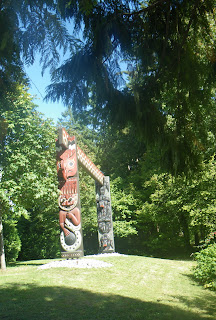 The Indian Village in Stanley Park
The Indian Village in Stanley Park
Some of the original older poles (as Skedans Mortuary Pole and Thunderbird House Post) were preserved to BC's museums and have been replaced by replicas.
The total number of totems at Brockton Point is now nine, the last one being added in 2009.
Since 2008 were installed also three carved gateways by Coast Salish artist Susan Point to welcome visitors to the park.
These portals were carved of red cedar and constructed to represent the traditional slant-roof style of Coast Salish architecture
The plaque that give general information about the NW Coastal Park art reads as follows:
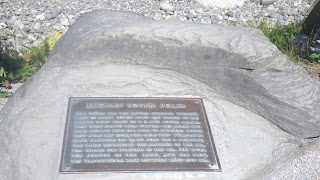 " The totem was the British Columbia Indians' "coat of arms". Totem poles are unique to the Northwest Coast of B.C. and lower Alaska. They were carved from Western red cedar and each carving tells of a real or mythical event. They were not idols, nor were they worshipped. Each carving on each pole has a meaning. The eagle represents the kingdom of the air, the whale, the lordship of the sea, the wolf, the genius of the land, and the frog, the transitional link between land and sea."
" The totem was the British Columbia Indians' "coat of arms". Totem poles are unique to the Northwest Coast of B.C. and lower Alaska. They were carved from Western red cedar and each carving tells of a real or mythical event. They were not idols, nor were they worshipped. Each carving on each pole has a meaning. The eagle represents the kingdom of the air, the whale, the lordship of the sea, the wolf, the genius of the land, and the frog, the transitional link between land and sea." 1. Oscar Maltipi Pole : Killer Whale with Thunderbird on top
1. Oscar Maltipi Pole : Killer Whale with Thunderbird on topThe following text is from plaques at the totem pole display in Vancouver's Stanley Park:
" First Nations origin stories tell of the animals and supernatural beings who helped found family lineages. These stories are celebrated in songs, dances and totem pole carvings. Kwakwaka'wakw artist Ocsar Maltipi carved this pole in 1968. Originally from Turnour Island, Maltipi trained at the Royal B.C. Museum under artist and teacher, Henry Hunt."
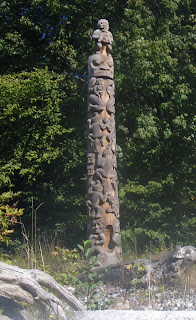
2. Beaver Crest Pole:
The following text is from plaque at the totem pole display:
"Carved in 1987 by Nisga'a artist Norman Tait along with his son Isaac, brother Robert, and nephew Ron Telek. The pole depicts how the Tait family's Eagle clan adopted the beaver as their crest and how the eagle and raven met and shared the sky"
"Once five brothers went to hunt beaver skins for a feast. The youngest brother helped the beavers escape and followed them to their lodge. He watched as they took off their beaver cloaks to reveal human forms and tell of the death and destruction of their chief. He watched their songs and dances, then returned home to report what he had seen. The brother performed the dances of the beaver people at a feast and raised a pole called Big Beaver. It was at this time that the Eagle Chief met and shared the skies with the Raven, which is another story."
 3. Chief Wakas Pole: Raven, Bear, Huxwhukw: a mythical bird; Wise one; Wolf; Killer whale; Thunderbird
3. Chief Wakas Pole: Raven, Bear, Huxwhukw: a mythical bird; Wise one; Wolf; Killer whale; ThunderbirdThe following text is from plaque at the totem pole display:
"In Kwarwaka'wakw ceremonies carved staffs called talking sticks are held by people making important speeches on behalf of the chief. This Pole represents the talking stick and characters in an Owikeno story belonging to Chief Wakas. The original pole was raised in front of the Chief Wakas house in Alert Bay in 1890. The raven's beak opened to form a ceremonial entrance to the house, while the raven's body was painted on the house front. Nimpkish artist Doug Cranmer, who has inherited Chief Wakas' crests, carved this new pole in 1987 "
 4. Sky Chief Pole: Man of Knowledge; Wolf, Lightning-snake; Whale; Thunderbird, Kingfiisher, Sky Chief holding moon.
4. Sky Chief Pole: Man of Knowledge; Wolf, Lightning-snake; Whale; Thunderbird, Kingfiisher, Sky Chief holding moon.
The following text is from plaque at the totem pole display:
"Hesquiat artist Tim Paul and Dididaht artist Art Thompson carved this pole in 1988 to represents important characters in Nuu-chah-nulth history"
5. Kakaso-Las Pole: Raven, Dzunukwa a giantess; Bak'was wild man of the woods; Frog, Man; Sea-bear holding a killer-whale; Thunderbird.
The following text is from plaque at the totem pole display:
" Kwakwaka'Wakw carver Elien Neel and her uncle Mungo Martin were among the first artists to achieve wide recognition for their totem poles commissioned by museums, cities and art collectors. Neel was also the first woman to become a Northwest Coast carver. This pole was completed in 1955 for Woodward's department store.
In memory of Neel's pioneering role in reaching an international audience through her art, the University of British Columbia Museum of Anthropology has loaned this pole to Stanley Park."
In memory of Neel's pioneering role in reaching an international audience through her art, the University of British Columbia Museum of Anthropology has loaned this pole to Stanley Park."
The following text is from plaque at the totem pole display:
"Carved House Posts are used in traditional First Nations cedar houses to support the huge roof beams.
This pole is a replica of a of a house post carved by Kwakwaka'Wakw artist Charlie James in the early 1900s. Tony Hunt carved this replica in 1987 to replace the older pole now in the Vancouver Museum. James exerimented with colours and techniques creating a bold new style that has influenced generations of artists including his step-son Mungo Martin and grand -daughter Ellen Neel. A pole by Ellen Neel stands to the left".
"Carved House Posts are used in traditional First Nations cedar houses to support the huge roof beams.
This pole is a replica of a of a house post carved by Kwakwaka'Wakw artist Charlie James in the early 1900s. Tony Hunt carved this replica in 1987 to replace the older pole now in the Vancouver Museum. James exerimented with colours and techniques creating a bold new style that has influenced generations of artists including his step-son Mungo Martin and grand -daughter Ellen Neel. A pole by Ellen Neel stands to the left".
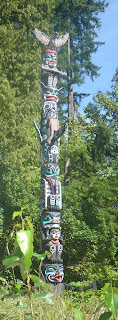 7. GA'AKSTALAS: Dzunukwa the giantess; Grizzly bear over the man's head; Raven; Killer whale; Siwidi; Sisiyutl double-headed serpent; Red Cedar -bark man with canoe; Quolus legendary bird.
7. GA'AKSTALAS: Dzunukwa the giantess; Grizzly bear over the man's head; Raven; Killer whale; Siwidi; Sisiyutl double-headed serpent; Red Cedar -bark man with canoe; Quolus legendary bird.
The following text is from plaque at the totem pole display:
" Carved by Wayne Alfred and Beau Dick in 1991, is based on a design by Russell Smith. The pole depicts many important figures in Kwakwaka'Wakw culture. Red Cedar-bark Man is an ancestor who survived the great flood and gave the people the first canoe. The hero Siwidi, shown riding a killer whale was taken under the sea to the home of the sea-world's chief and brought back the right to use all of the sea-kingdom masks. The giantess dzunukwa sits at the base of the pole, symbolizing her central role in bringing magic and wealth to her people. "
8. Chief Skedans Mortuary Pole: Whale; Grizzly Bear; Mountain goat; Moon: a chief's crest.
"An older version of this pole was raised in the Haida village of Skidegate about 1870. It honours the Raven Chief of Skedans and depitcts the chief's hereditary crests. The two tiny figures in the bear's ears are the chief's daughter and son-in-law who erected the pole and gave a potlatch for the chief's memorial " Carved by Wayne Alfred and Beau Dick in 1991, is based on a design by Russell Smith. The pole depicts many important figures in Kwakwaka'Wakw culture. Red Cedar-bark Man is an ancestor who survived the great flood and gave the people the first canoe. The hero Siwidi, shown riding a killer whale was taken under the sea to the home of the sea-world's chief and brought back the right to use all of the sea-kingdom masks. The giantess dzunukwa sits at the base of the pole, symbolizing her central role in bringing magic and wealth to her people. "
8. Chief Skedans Mortuary Pole: Whale; Grizzly Bear; Mountain goat; Moon: a chief's crest.
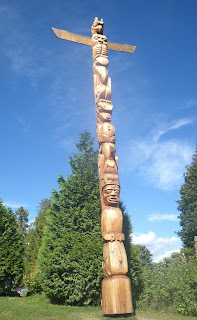 The rectangular board at the top of the original pole covered a cavity that held the chief's remains. Haida artist Bill Reid with assistant Werner True, carved this new pole in 1964. Don Yeomans recarved the top moon face in 1998. "
The rectangular board at the top of the original pole covered a cavity that held the chief's remains. Haida artist Bill Reid with assistant Werner True, carved this new pole in 1964. Don Yeomans recarved the top moon face in 1998. "9. Since 2009 a new unpainted totem pole carved by Robert Yelton of the Squamish Nation was added, as a tribute to his mother, Rose, who was one of the last residents of Stanley Park, and now the total number of totems at Brockton Point is nine.
Getting there by car take the right turn just as you enter the Stanley Park off Georgia Street. There is a parking lot nearby and various parking areas around the park.
View Indian Totem Poles of Brockton Point, Stanley Park, Vancouver in a larger map
See my other article about Totem poles, here: "Capilano Suspention Bridge Totem poles"




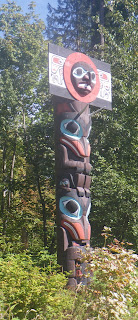
1 comment:
x0g89m4j96 v6m11h6m18 j0o77k7w94 d8m23s3s82 n4h08r0x63 h8d50v1h10
Post a Comment